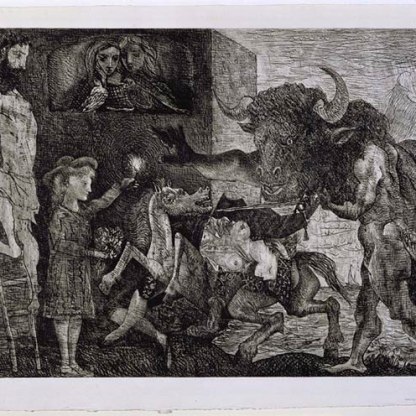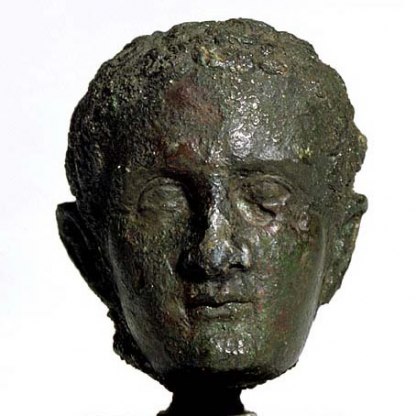Presages of the Millennium
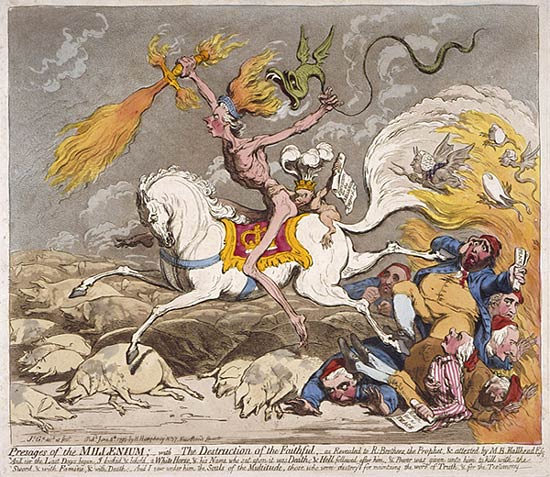
In 1793, the Conservative Prime Minister of England, William Pitt, declared war on France. Many of his compatriots however, prominent among them Charles James Fox, the leader of the liberal Whig party, were sympathetic to the French regime that had been established after the Revolution of 1789. This spirited cartoon lampoons the various reactions to the new war.
It is a testament to James Gillray's skill as a satirist that he here manages to make fun of all the parties represented. He was in fact an admirer and friend of Pitt, and the vehemence of some of his other works suggests a strong personal revulsion against the French Revolution. Below is a print in the Fitzwilliam [P.300-1948], entitled The Blood of the Murdered Crying out for Vengeance. It was made in 1793 and depicts the execution of the French King Louis XVI on 21 January that year. The dead monarch's blood streams plaintively heavenwards, demanding justice. It is clear where the artist's sympathies lie.

There is no such obvious partisanship, however, in Presages of the Millennium. Here all is folly: both the hawkish Tory government and the pacifist Whig opposition are made to look equally absurd. Gillray even manages to fit in a scurrilous swipe at the British royal family.
The Prime Minister Pitt is depicted as Death from the New Testament Book of Revelation. A band around his head reads 'DESTRUCTION' and, flaming sword in hand, he rides his white Hanoverian steed, all powerful, over his political opponents and herds of swine.
The identification of Pitt with Death allows Gillray to make fun of his notoriously emaciated figure. In a cartoon from 1792, which also alludes to the Book of Revelation, the cartoonist dubs him 'The Bottomless Pitt', a reference to the Prime Minister's unfeasibly skinny buttocks. A roughly contemporary stoneware medallion in the Fitzwilliam, below [PER.C.2-1922], which was probably modelled by the great neo-classical sculptor John Flaxman, provides a more dignified image of the statesman, but we can recognise at once the long neck and pointed nose that are such features of Gillray's Death figure.
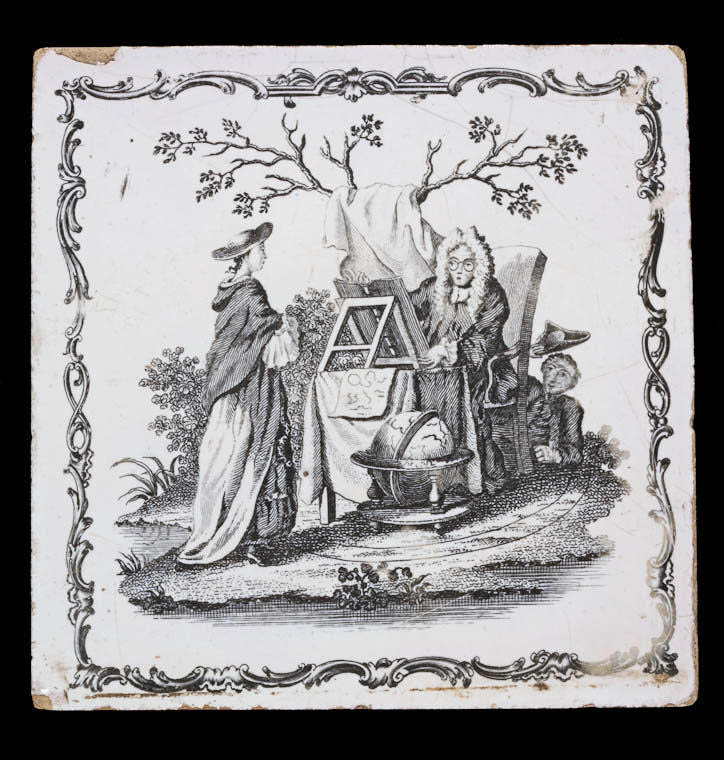
Skinny though the cheeks of Pitt's bottom may have been, they are shown here being kissed by the fat lips of a goblin-like George, Prince of Wales, identifiable by the motto 'Ich Dien' ('I serve'), and the three ostrich feathers on his crown. The Prince, who would become George IV in 1820, holds up a scroll on which we read the words 'Provision for the Millennium £250,000 per annum'. During the war with France, while taxes in England rose sharply, the Prince maintained a lavish, not to say gross, state-funded lifestyle.
Behind Pitt, in the fiery slipstream of his horse, a horned figure with a pitchfork and a tartan sash is recognisable as Henry Dundas, the Secretary of State for War. This staunch ally of the Prime Minister also appears in another Gillray cartoon, below [P.248-1948], entitled Weird Sisters, Ministers of Darkness, Minions of the Moon. It casts Dundas, Pitt and the influential but corrupt lawyer Baron Thurlow as the witches from Shakespeare's Macbeth. The face of the mad king, George III, can be seen in the moon above them.
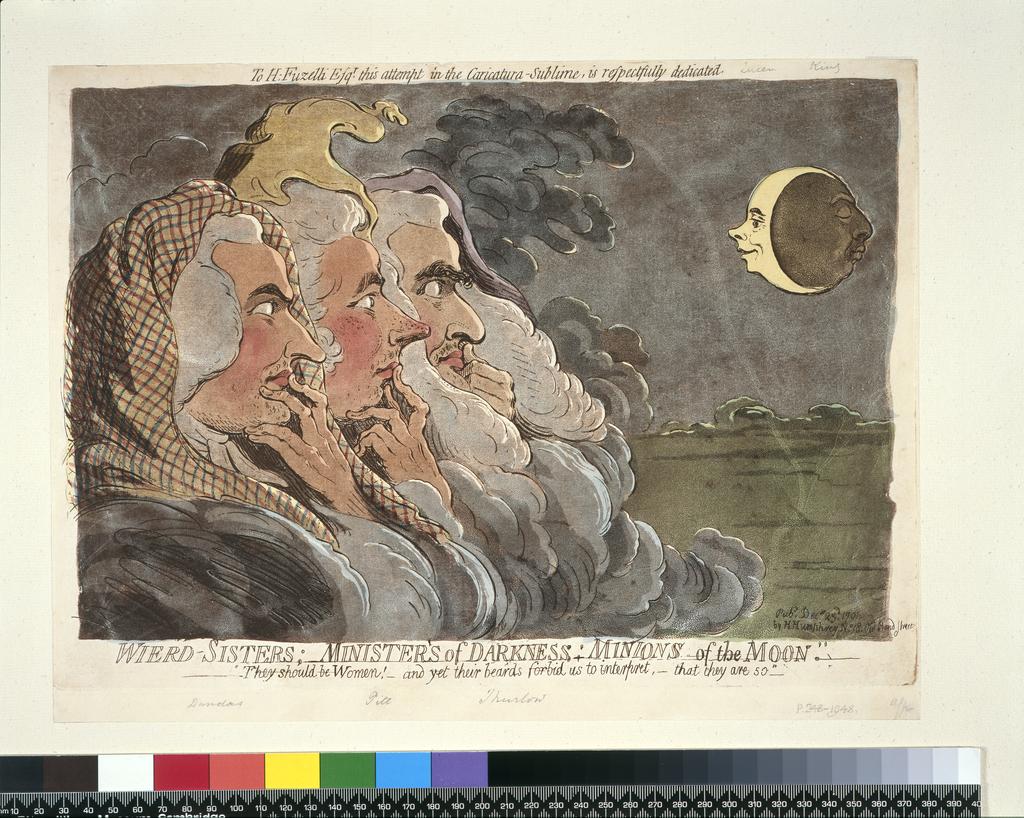
Also recognisable (left in the centre), with his pointed nose and glasses, is Edmund Burke. He had originally been in opposition to the Tories, but his strong aversion to the French Revolution led to his supporting the war against France. An unfinished double portrait from c. 1766 by Joshua Reynolds in the Fitzwilliam, below [653], shows him as a younger man with Lord Rockingham, Prime Minister between July 1765 and 1766. Burke is the figure on the left.

The back heels of Pitt's stallion kick at a crowd of opposition M.P.s. Fat and bearded, a hand clasped in horror to his face, is the Whig leader Charles James Fox, who, of all the English politicians, was the butt of Gillray's most savage caricatures. Here he clasps a scroll emblazoned with the word 'PEACE'. He drools a red liquid down his front – blood or his beloved port?
Behind Pitt three figures cower, probably representing the radical politician John Horne Tooke, Charles Stanhope, a former ally of Pitt who opposed the war, and Lord Grafton.
Directly beneath Fox, recognizable for his exaggeratedly retroussé nose, is William Wilberforce, the great philanthropist who is perhaps best known today for his anti-slavery campaigns. Although a personal friend of Pitt, the scroll in his hand, entitled 'Motion for a PEACE', shows just where he stood on war with France.
Wilberforce's feet rest upon the ruddy, mottled head of the prostrate Richard Brinsley Sheridan, the Irish playwright, bon viveur and ally of Fox. It is he who is closest to and most resembles the swine who flee or lie trampled beneath the horse's hooves.
As a caption, Gillray has adapted Chapter 6, verses 8–9, of the New Testament Book of Revelation:
And e'er the Last days began, I looked & beheld a White Horse, & and his name was Death, & Hell followed after him, & Power was given unto him to kill with the Sword, & with Famine, & with Death. And I saw under him the Souls of the Multitude, those who were destroy'd for maintaining the word of Truth, & for the Testimony.
The Book of Revelation was a popular source for British artists towards the end of the eighteenth century. William Blake's watercolour, Death on A Pale Horse, in the Fitzwilliam, below [765] was made c. 1800 and provides an interesting comparison with Gillray's cartoon. One gets the impression that, while Gillray makes merry with contemporary anxieties about the imminence of the Apocalypse, Blake takes them rather more seriously.

Themes and periods
Data from our collections database
Acquisition and important dates
- Method of acquisition: Given
- Dates: 1948
Dating
Published June 4th 1795
- 18th Century
- Production date: AD 1795
Maker(s)
- Gillray, James Printmaker
- Humphrey, Hannah Publisher
Note
Published June 4th 1795
Read more about this recordStories, Contexts and Themes
Other highlight objects you might like
Suggested Curating Cambridge products
Sign up to our emails
Be the first to hear about our news, exhibitions, events and more…



